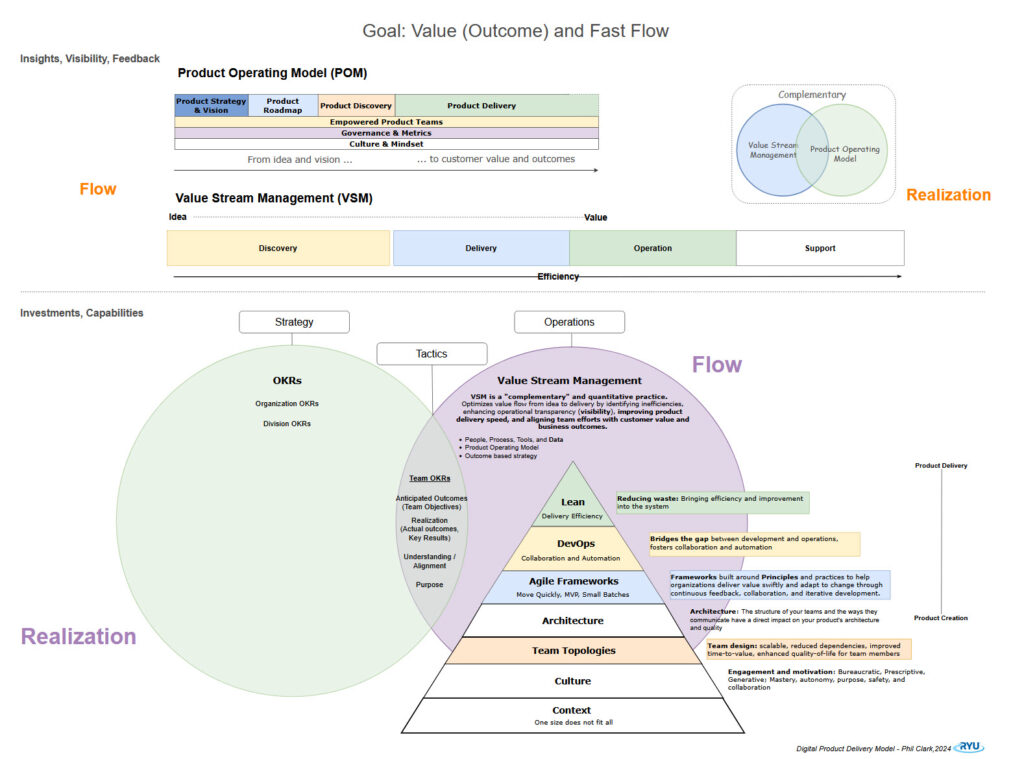If there’s a theme to my career, it’s this: technology works best when we stop treating it like a cost center and start leading it like a strategic partner. My mission is to help others see—and build—that future.
Practices
Focus on value and improve delivery efficiency, throughput, and accelerate time to value with highly engaged team members
Value Stream Management and Flow Metrics became the unifying principle introduced in late 2020, early 2021 in the department I oversee within the organization—ensuring that all incremental improvements in agility, engineering automation, and team structures ultimately drove better business outcomes through improved flow efficiency.
A Product Operating Model is a strategic framework that aligns an organization’s structure, processes, and culture around delivering continuous value through products. This model represents a significant shift from the traditional project-centric approach, which was prevalent during the Industrial Revolution, to a more dynamic and customer-centric product-focused mindset.

As a software engineer and technology leader with 25 years of experience spanning both waterfall and agile eras, I’ve heard the same refrain: “Technology is a cost center.” I’ve participated in reduction-in-force initiatives, stacked ranking exercises, and engineering team cuts—all driven by this persistent mindset. This experience has shaped my mission today: fundamentally changing how organizations view technology investments by directly linking our work to business and customer outcomes.
Pushing boundaries is essential to achieving fast flow and delivering value. However, managing “knowledge work” presents unique challenges. In most cases, we rely on predictions — our best guesses — about outcomes and timelines, often navigating unknowns in new requests. Leaders expect accuracy, yet the reality of uncertainty demands adaptability.
Over my career, I’ve witnessed how great teams operate and how leadership can drive or derail success. Our teams deliver more frequently, allowing us to minimize the risk of building the wrong solutions while ensuring we provide more significant, more precise strategic value. By combining modern practices and tools with our advanced infrastructure, we deliver value more quickly, safely, and efficiently.
- What: Deliver value through fast flow based on anticipated outcomes and impact on our customers in business.
- How: Leverage practices and frameworks that enable faster feedback, reduce risks, and minimize wasted efforts. By implementing a mix of culture, team design, architecture, Agile, Lean, DevOps, Value Stream Management, OKRs, and modern infrastructure, organizations can pivot quickly and respond to real-time feedback — staying on course, adjusting direction, or halting when necessary.
- Measure Success: The approach prioritizes efficiency and drives desired business outcomes. By leveraging Data-driven insights through Outcome and Flow metrics, we foster continuous feedback to refine processes and minimize uncertainty around value impact.
Fast flow happens when friction fades. You may never remove it all, but reducing it—truly reducing it—feels like magic. – Phil Clark
Mission
I aim to expose software engineering as a strategic partner, not just a cost center.
First: Linking technology investments to business results. Transforming how organizations approach technology investments by directly tying them to tangible business and customer outcomes.
I leverage Value Stream Management, Flow Metrics, Agile, Lean, and DevOps principles, combined with anticipated Outcomes and OKRs, to help organizations achieve greater visibility, alignment, and accountability. My approach ensures that every development initiative delivers meaningful and measurable business results.
Step 2: Enhance clarity of team purpose. Foster alignment by connecting teams to the outcomes they deliver and the impact they create.
Just as leaders must clarify how technology investments align with business outcomes, this alignment must also work both ways. Many engineering teams operate in a vacuum, disconnected from the value their work creates—whether it’s increasing revenue, reducing churn, improving operational efficiency, or driving market differentiation. When teams understand the impact of their work on the business, they become more engaged and fulfilled.
Art of the possible:
Many organizations find this challenging, and it’s not as straightforward as it appears, particularly at scale. However, it is certainly attainable. If you don’t see this mission as inspiring, you likely haven’t been part of a department or organization that has successfully developed these capabilities. Once you experience that, you and your teams will undoubtedly feel a true sense of inspiration.
Having successfully led teams through both very different software delivery eras, I’ve never been more passionate about my role than I am now. The industry’s evolving practices and tools have transformed what is possible, fueling my enthusiasm further.
I aim to continue to build teams and an organization that are referenced in the industry.
How?
I am dedicated to making a meaningful impact on teams, organizations, and customers by delivering the right digital products efficiently. A powerful way to approach this is by utilizing modern practices, a Product Operating Model, and data driven insights.
We build strong teams (people first), processes, and technology. While all three are essential, putting people and processes first is key to achieving long-term success. How you deliver software is critical, and I appreciated finding this message from Mark Zuckerberg in January 2025. He nails it! Velocity is a key part of product strategy:
“I view the product strategy less as any one specific thing, and more as how do we iterate and learn as quickly as possible…If we can learn faster than every other company, we’re going to win.”
In today’s competitive landscape, teams that ship the fastest win.”
Video excerpt from Zuckerberg’s interview on the “Acquired” podcast, recorded live at the Chase Center on September 10, 2024.
Final thoughts: Highly effective teams focus on work aligned to anticipated outcomes, helping them work with clear alignment and purpose. By staying focused on results, these teams boost engagement and deliver more impactful results for every dollar invested in their success.
